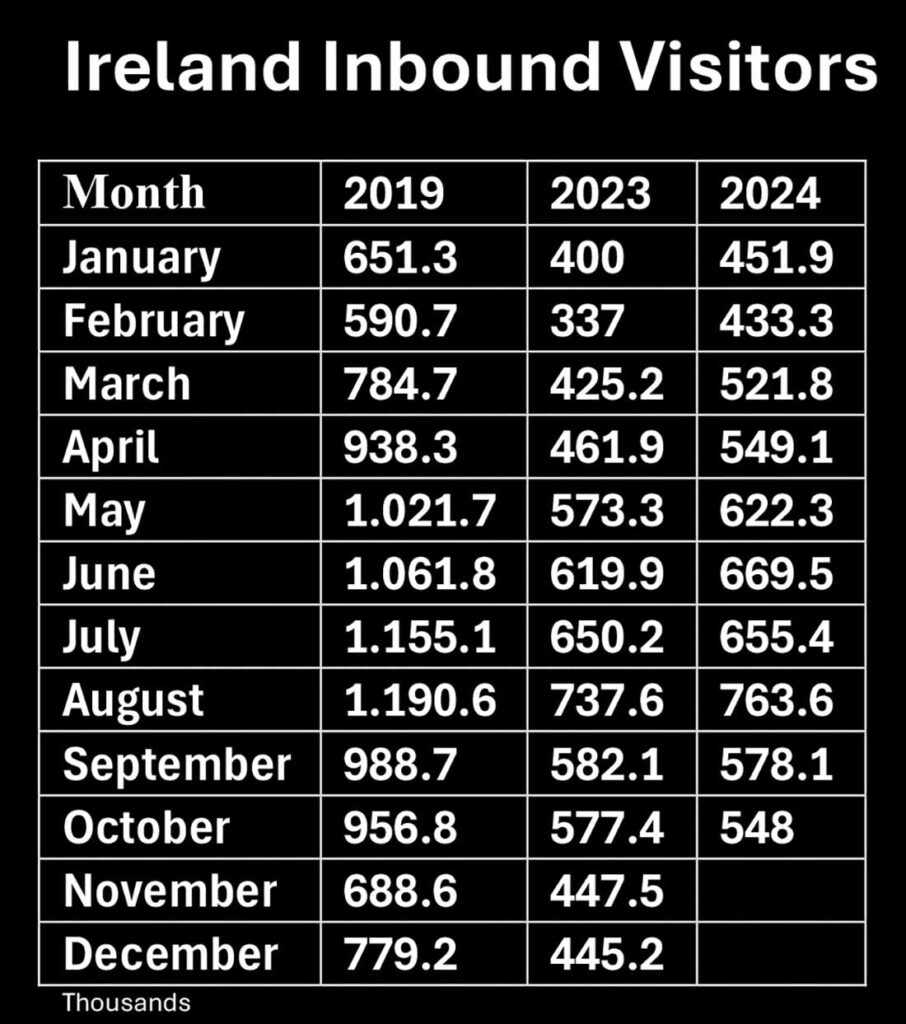
Foreign visitor numbers to Ireland for the ten months to October are still 22pc behind pre-pandemic, according to data from the Central Statistics Office. The CSO cautions that a change in collection methodology may have affected the figures.
Expenditure in Ireland increased by 3.6pc in October 2024 from October 2023, reaching €534.3m, despite a 5.1pc decrease in visitor numbers over the period.
The majority of visitors came from England, Scotland and Wales (32.6pc), followed by the United States (21.7pc), and Germany (8.1pc), with 44.2pc traveling for holiday or leisure purposes.
The total number of nights stayed by visitors was 3.9m, with an average length of stay of 7.1 nights, an increase from 6.9 nights in October 2023.
The most significant revenue came from North American visitors, who accounted for 42.5pc of all visitor expenditure, followed by visitors from continental Europe.
In October 2024 the typical foreign visitor spent €1,311 (€975 excluding fares) on their trip to Ireland, breaking down as €337 on their fare, €45 on prepayments, €441 on accommodation, and €489 on day-to-day expenses. In October 2023 the comparable mean expenditure on these items was €311 on fare, €52 on prepayments, €412 on accommodation, and €429 on expenses.
So far in 2024 Ireland has hosted 5.79m up 8pc compared to the same period of 2023, spending €5.38bn up 15pc compared to the same period of 2023.
Alice Mansergh of Tourism Ireland shared “It is positive to see that overseas tourism spend so far in 2024 has grown +15pc compared to the same period in 2023, with Mainland Europe, Great Britain and North America all demonstrating revenue growth. This growth is vital for the tourism industry, at a time when cost inflation means margins are tight, and we’re proud to support demand growth through our overseas marketing. October as a standalone month grew also in terms of overseas tourism spend compared to October 2023, at almost +4pc, but there are some visible challenges or risks to navigate that show up in this month’s data. Visitors in October spent +9pc more per trip, and while almost 550,000 visitors chose to come to Ireland, this was -5pc fewer than in October 2023, driven by a softening from Great Britain and the first dip in volumes of visitors from North America that we’ve seen this year – albeit that October was the month before the US election. There are some constraints ahead, with air access limited for the winter season by the cap at Dublin airport, which is on hold for summer 2025, but has already been applied for winter 2024. Despite growth at regional airports, the cap at Dublin has an impact, as it is the airport typically supporting ~70pc of air access to the island of Ireland and ~85pc of air access for Ireland exclusive of Northern Ireland. With Dublin at 96pc of the air seat capacity it had last winter, the island overall dips to 99pc of the air seat capacity or air access it had last year, with markets such as Great Britain and North America affected, at 97pc and 96pc seat capacity respectively for winter 2024 vs winter 2023.
“Tourism Ireland welcomes steps being taken to review the cap at Dublin airport as a priority. In the meantime, we are partnering with air and sea carriers to support growth in demand for routes directly into the regions, to mitigate risk where possible. This winter, we are promoting reasons to explore across seasons, we have publicity programmes under way across 13 markets and we will be launching kickstart campaigns across TV and digital channels overseas to inspire bookings to come and explore Ireland as a top destination for 2025. December is often a key period when people begin to consider their main holidays for the year ahead and we will be supporting the tourism industry to win hearts, minds and trips. Challenges in volumes of visitors may persist through the winter, with air seat capacity to the island at 99pc the level of winter 2023. While regional and Northern Ireland airports are showing strong growth, Dublin – as the largest airport – has 96% of the seat capacity it had in winter 2023, due to the airport cap applied this winter. While there is a ‘hold’ for legal consideration of the airport cap for summer 2025, there is still impact from applying the cap in winter 2024. Island wide, air seat capacity for the winter from Great Britain has dipped to 97pc the level of 2023 and from North America to 96% of the level of 2023.





